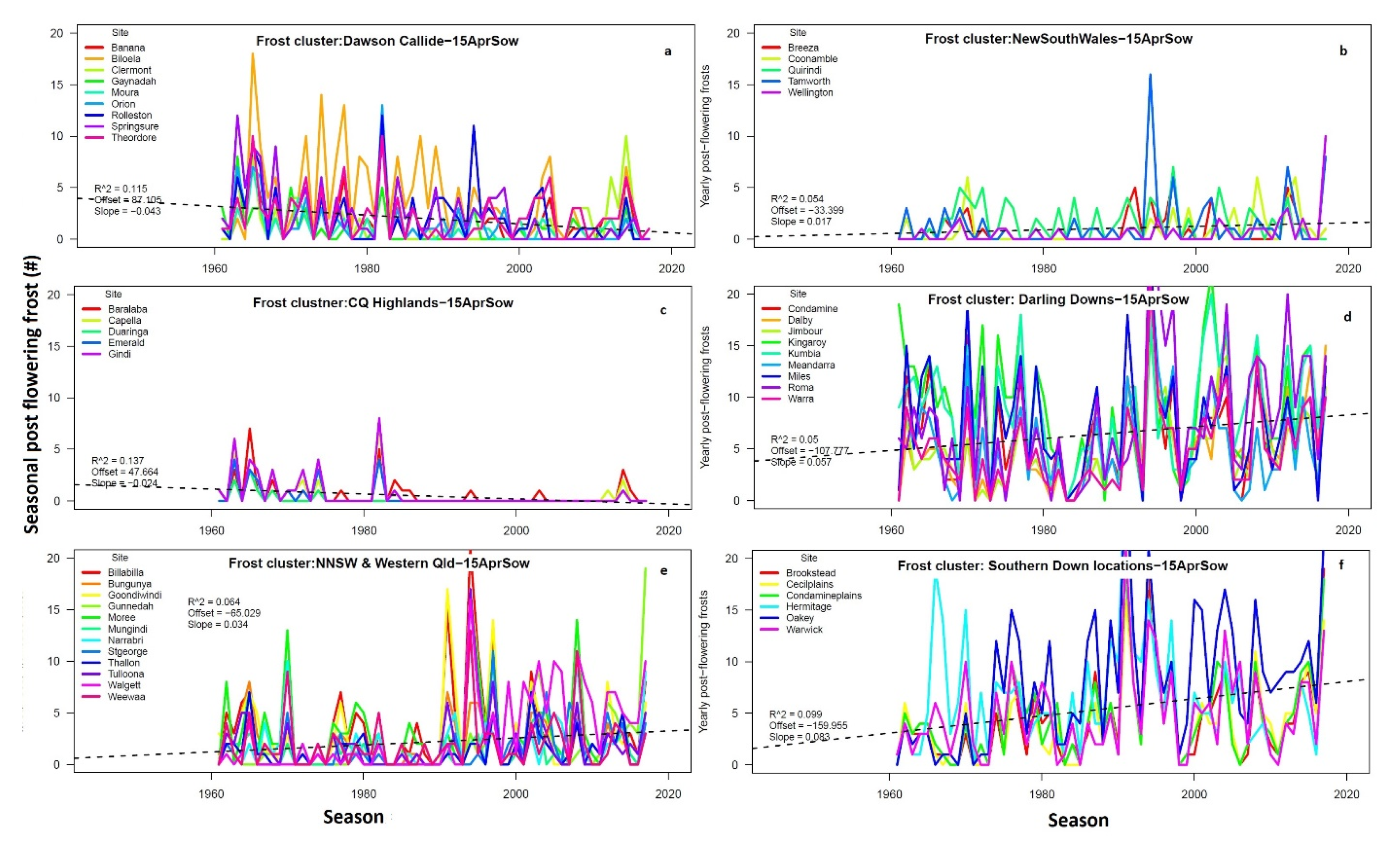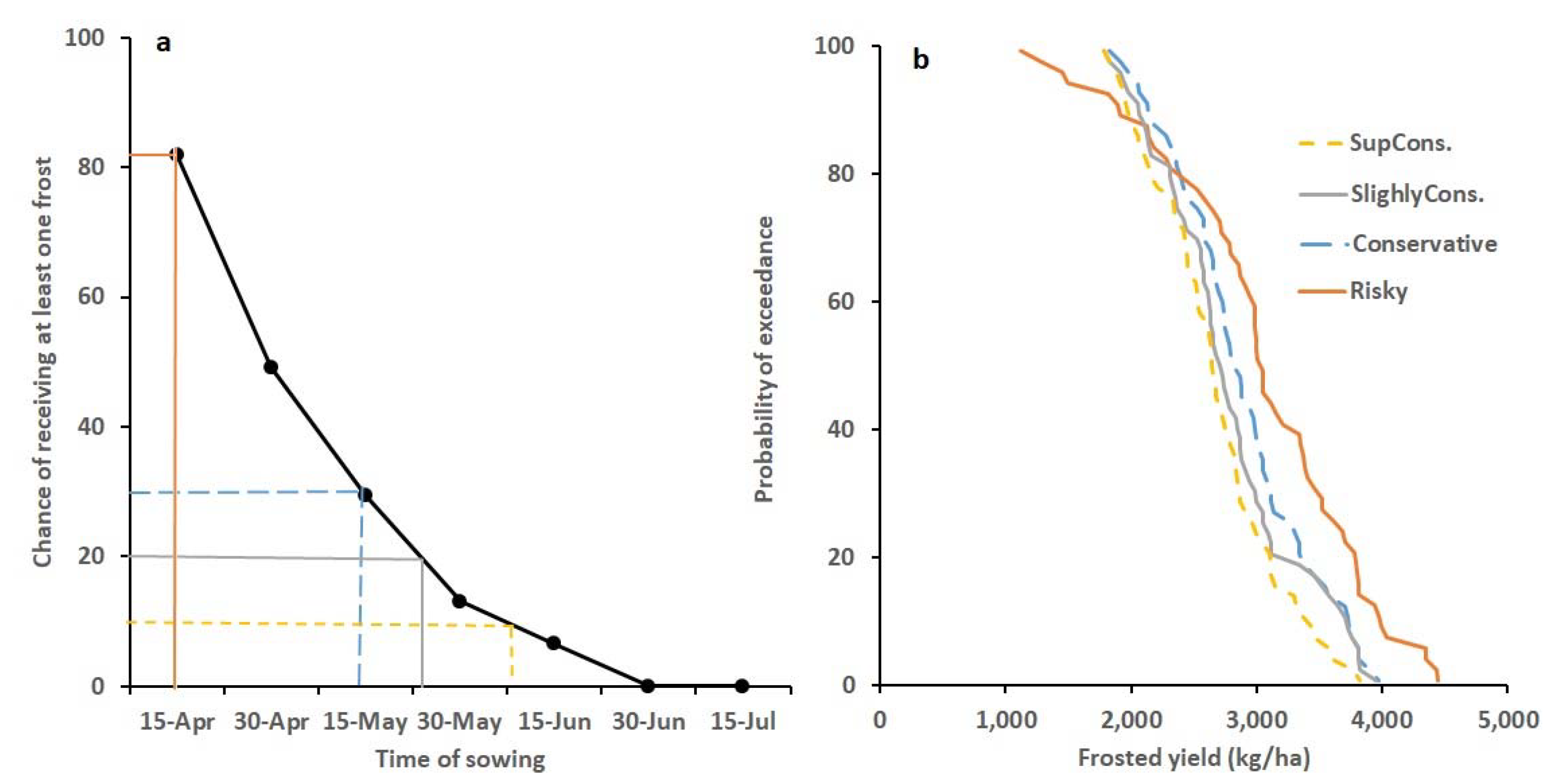Frost Risk Management in Chickpea Using a Modelling Approach
Abstract
1. Introduction
2. Materials and Methods
2.1. Mapping of Frost Risk Using Agricultural Production Systems Simulator (APSIM)
2.2. Spatial and Temporal Frost Risk
2.3. Frost Management Strategy
2.4. Genotype × Environment × Management Interactions
2.5. Statistical Analysis
3. Results and Discussion
3.1. Spatial and Temporal Trends in Frost Risk
3.2. Strategies to Minimise Frost risk
3.3. Genotype × Environment × Management Interactions Related to Frost and Drought
4. Conclusions
Author Contributions
Funding
Acknowledgments
Conflicts of Interest
References
- Goyne, P.J.; Meinke, H.; Milroy, S.P.; Hammer, G.L.; Hare, J.M. Development and use of a barley crop simulation model to evaluate production management strategies in north-eastern Australia. Aust. J. Agric. Res. 1996, 47, 997–1015. [Google Scholar] [CrossRef]
- McDonald, G.; Sutton, B.; Ellison, F. The effect of time of sowing on the grain yield of irrigated wheat in the Namoi Valley, New South Wales. Aust. J. Agric. Res. 1983, 34, 229–240. [Google Scholar] [CrossRef]
- Zheng, B.; Chenu, K.; Fernanda Dreccer, M.; Chapman, S.C. Breeding for the future: What are the potential impacts of future frost and heat events on sowing and flowering time requirements for A ustralian bread wheat (T riticum aestivium) varieties? Glob. Chang. Biol. 2012, 18, 2899–2914. [Google Scholar] [CrossRef] [PubMed]
- Crimp, S.J.; Zheng, B.; Khimashia, N.; Gobbett, D.L.; Chapman, S.; Howden, M.; Nicholls, N. Recent changes in southern Australian frost occurrence: Implications for wheat production risk. Crop Pasture Sci. 2016, 67, 801–811. [Google Scholar] [CrossRef]
- Zheng, B.; Chapman, S.C.; Christopher, J.T.; Frederiks, T.M.; Chenu, K. Frost trends and their estimated impact on yield in the Australian wheatbelt. J. Exp. Bot. 2015, 66, 3611–3623. [Google Scholar] [CrossRef] [PubMed]
- ABARES. Pulse Australia Crop Report Data. 2019. Available online: https://www.agriculture.gov.au/sites/default/files/documents/austcroprrt20191203_v1.0.0.pdf (accessed on 15 January 2020).
- McKenzie, B.; Hill, G.; Gunaratnam, R.; Jones, A. Evaluation of the ICARDA cold tolerant chickpea nursery. In Proceedings of the Agronomy Society of NZ, Lincoln University, Canterbury, UK, 30 March 1995; pp. 47–50. [Google Scholar]
- Clarke, H.; Siddique, K. Response of chickpea genotypes to low temperature stress during reproductive development. Field Crop. Res. 2004, 90, 323–334. [Google Scholar] [CrossRef]
- Whish, J.P.M.; Castor, P.; Carberry, P.S.; Peake, A.S. On-farm assessment of constraints to chickpea (Cicer arietinum) production in marginal areas of northern Australia. Exp. Agric. 2007, 43, 505–520. [Google Scholar] [CrossRef]
- Singh, K.; Saxena, M.; Gridley, B. Screening Chickpea for Cold Tolerance and Frost Resistance. Ascochyta Blight and Winter Sowing of Chickpeas; Martinus Nijhoff/Dr. W. Junk. Pub.: The Hague, The Netherlands, 1984; pp. 167–177. [Google Scholar]
- Chauhan, Y.S.; Ryan, M.; Chandra, S.; Sadras, V.O. Accounting for soil moisture improves prediction of flowering time in chickpea and wheat. Sci. Rep. 2019, 9, 7510. [Google Scholar] [CrossRef] [PubMed]
- Flohr, B.M.; Hunt, J.R.; Kirkegaard, J.A.; Evans, J.R. Water and temperature stress define the optimal flowering period for wheat in south-eastern Australia. Field Crop. Res. 2017, 209, 108–119. [Google Scholar] [CrossRef]
- Howden, S.; Power, B.; Mckeon, G. Risk management of wheat in a non-stationary climate: Frost in Central Queensland. In Proceedings of the Integrative Modelling of Biophysical, Social and Economic Systems for Resource Management Solutions: International Congress on Modelling and Simulation, Townsville, Queensland, Australia, 14–17 July 2003; pp. 17–22. [Google Scholar]
- Holzworth, D.P.; Huth, N.I.; deVoil, P.G.; Zurcher, E.J.; Herrmann, N.I.; McLean, G.; Moore, A.D. APSIM–evolution towards a new generation of agricultural systems simulation. Environ. Model. Softw. 2014, 62, 327–350. [Google Scholar] [CrossRef]
- Robertson, M.J.; Carberry, P.S.; Huth, N.I.; Turpin, J.E.; Probert, M.E.; Poulton, P.L.; Brinsmead, R.B. Simulation of growth and development of diverse legume species in APSIM. Aust. J. Agric. Res. 2002, 53, 429–446. [Google Scholar] [CrossRef]
- Chauhan, Y.; Allard, S.; Williams, R.; Williams, B.; Mundree, S.; Chenu, K.; Rachaputi, N.C. Characterisation of chickpea cropping systems in Australia for major abiotic production constraints. Field Crop. Res. 2017, 204, 120–134. [Google Scholar] [CrossRef]
- R Core Team. R: A Language and Environment for Statistical Computing; R Foundation for Statistical Computing: Vienna, Austria, 2018. [Google Scholar]
- Neenu, S.; Ramesh, K.; Ramana, S.; Somasundaram, J. Effect of cultivars and sowing dates on nutrient uptake and yield of chickpea under aberrant climatic conditions in black soils of central India. Adv. Res. 2017, 12, 1–11. [Google Scholar] [CrossRef]







© 2020 by the authors. Licensee MDPI, Basel, Switzerland. This article is an open access article distributed under the terms and conditions of the Creative Commons Attribution (CC BY) license (http://creativecommons.org/licenses/by/4.0/).
Share and Cite
Chauhan, Y.S.; Ryan, M. Frost Risk Management in Chickpea Using a Modelling Approach. Agronomy 2020, 10, 460. https://doi.org/10.3390/agronomy10040460
Chauhan YS, Ryan M. Frost Risk Management in Chickpea Using a Modelling Approach. Agronomy. 2020; 10(4):460. https://doi.org/10.3390/agronomy10040460
Chicago/Turabian StyleChauhan, Yashvir S., and Merrill Ryan. 2020. "Frost Risk Management in Chickpea Using a Modelling Approach" Agronomy 10, no. 4: 460. https://doi.org/10.3390/agronomy10040460
APA StyleChauhan, Y. S., & Ryan, M. (2020). Frost Risk Management in Chickpea Using a Modelling Approach. Agronomy, 10(4), 460. https://doi.org/10.3390/agronomy10040460




